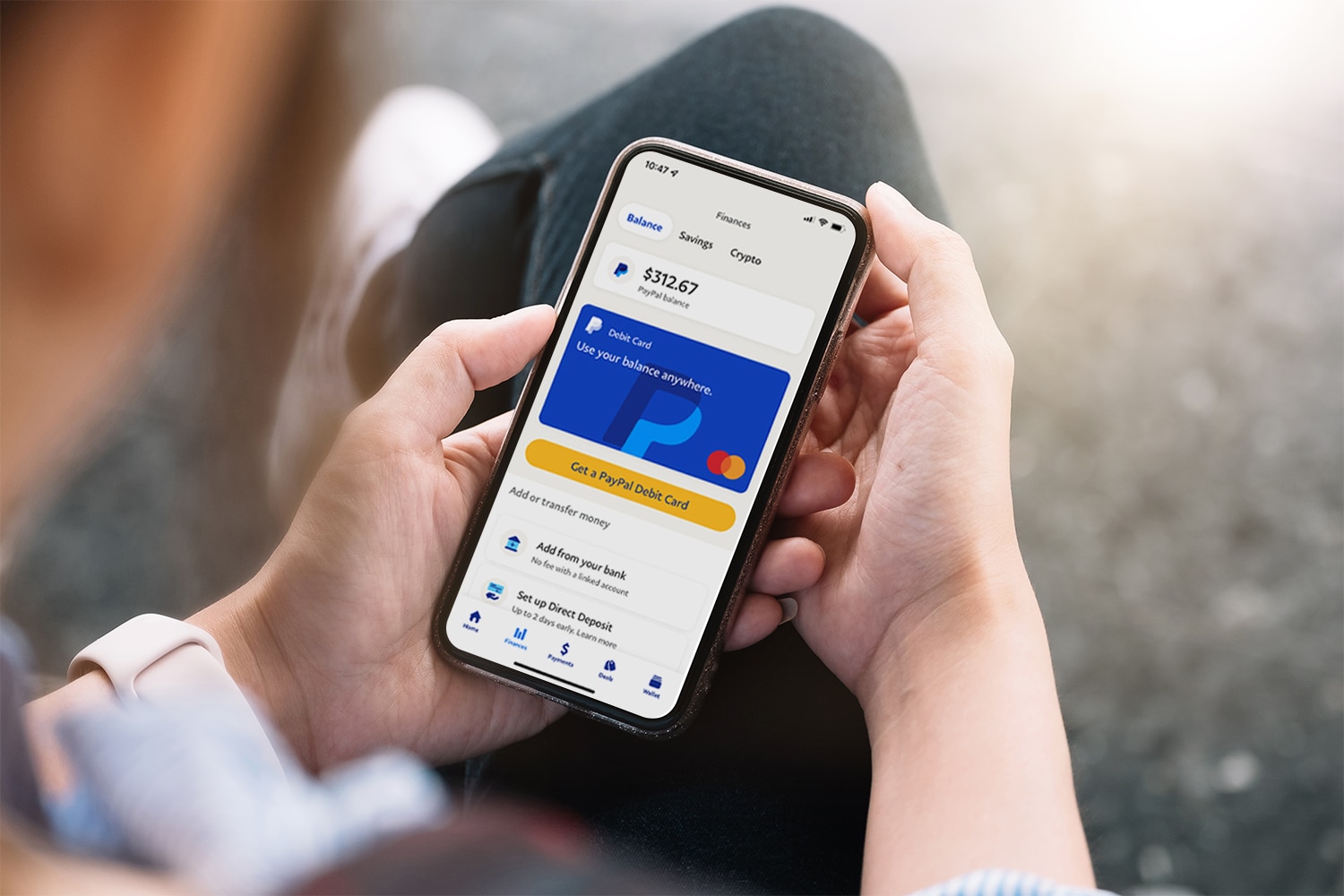

Finance
How Does Online Savings Work
Published: January 16, 2024
Learn how online savings work and how they can help you manage your finances more effectively. Discover the benefits and start saving today!
(Many of the links in this article redirect to a specific reviewed product. Your purchase of these products through affiliate links helps to generate commission for LiveWell, at no extra cost. Learn more)
Table of Contents
Introduction
Welcome to the digital era of finance! With the advancement of technology and the widespread use of the internet, managing your money has never been easier. One of the most convenient features offered by financial institutions today is online savings accounts. In this article, we will explore what online savings accounts are, the benefits they provide, how to open and manage them, and the importance of safety and security.
Online savings accounts have revolutionized the way we save money. Gone are the days of visiting a brick-and-mortar bank and standing in long queues. With just a few clicks, you can access your savings account, deposit funds, track your progress, and even earn interest on your balance. But how does it all work?
An online savings account is essentially a banking account that is operated entirely online. Instead of physically going to a bank or credit union, you can manage your savings through a secure website or mobile application. This means that you can access and manage your account from anywhere, at any time, as long as you have an internet connection.
Not only are online savings accounts convenient, but they also offer a range of benefits that traditional savings accounts may not provide. These benefits include higher interest rates, lower fees, and easy access to your funds. Online savings accounts are an attractive option for individuals who want to maximize their savings potential and maintain control over their finances.
In the following sections, we will delve deeper into the world of online savings accounts and explore the various features and options they offer. Whether you are a seasoned saver or just starting your financial journey, understanding how online savings accounts work can help you make informed decisions to reach your savings goals.
What is online savings?
Online savings refers to the practice of saving money in a digital format, typically through an online savings account offered by a financial institution. With online savings accounts, individuals can securely deposit and manage their funds through a website or mobile application, eliminating the need for physical visits to a bank.
Online savings accounts function similarly to traditional savings accounts, with a few key differences. The primary distinction is the accessibility and convenience provided by online platforms. Rather than relying on in-person transactions or paper statements, account holders can easily monitor their savings, make deposits or withdrawals, and track their progress towards their financial goals, all through their preferred device.
Online savings accounts are typically linked to a traditional bank, credit union, or online-only financial institution. These accounts offer many of the same features as their offline counterparts, such as FDIC or NCUA insurance, which protect account holders’ funds up to a certain amount.
Some online savings accounts may also come with additional perks, such as higher interest rates compared to traditional savings accounts. This is because online banks often have lower overhead costs and can pass those savings onto their customers in the form of competitive interest rates.
It’s important to note that online savings accounts are not the same as online-only banks. While online-only banks operate exclusively through digital channels and offer a wide range of financial services, including savings accounts, online savings accounts can be found at various types of financial institutions, both online-only and traditional.
Overall, online savings accounts provide individuals with a convenient and efficient way to save money. They offer the flexibility to manage one’s finances at any time and from anywhere, making it easier to track progress, set savings goals, and ultimately achieve financial stability.
Benefits of online savings
Online savings accounts offer numerous benefits that make them an attractive option for individuals looking to grow their savings. Here are some of the key advantages of online savings:
- Convenience: Online savings accounts provide unparalleled convenience. With just a few clicks, you can access your account, check your balance, make deposits or withdrawals, and track your savings progress. There’s no need to visit a physical bank branch or adhere to restricted banking hours. You have the flexibility to manage your savings whenever and wherever it is most convenient for you.
- Higher interest rates: One of the biggest advantages of online savings accounts is the potential for higher interest rates. Online banks often have lower overhead costs, allowing them to offer more attractive rates compared to traditional banks. This means that your savings can grow faster, helping you reach your financial goals more quickly.
- Lower fees: Online savings accounts generally come with fewer fees compared to traditional savings accounts. While offline banks may charge monthly maintenance fees or fees for certain transactions, online banks tend to offer fee-free or low-fee accounts. This can help you save even more money in the long run.
- Ease of access: With online savings accounts, your funds are just a few clicks away. Most online banks provide convenient and secure ways to access your money, such as online transfers, mobile check deposits, and even ATM access through partner networks. Whether you need to pay for an unexpected expense or access funds for a planned purchase, you can do so quickly and effortlessly.
- Automation and goal tracking: Many online savings accounts come equipped with automation features that can simplify your saving process. You can set up automatic transfers from your checking account to your savings account, ensuring that you consistently save without having to think about it. Additionally, online platforms often provide goal tracking tools, allowing you to monitor your progress and stay motivated as you work towards achieving your savings goals.
- Flexibility and options: Online savings accounts offer a range of options to suit your needs. Whether you prefer a high-yield savings account, a certificate of deposit (CD), or a money market account, online banks often provide a variety of choices. You can select the account that aligns with your financial goals and risk tolerance, giving you greater control over your savings strategy.
These benefits make online savings accounts an appealing choice for individuals seeking a convenient, cost-effective, and flexible way to save money. As technology continues to advance, online banking solutions will only become more advanced and accessible, offering even greater advantages for savers.
Opening an online savings account
Opening an online savings account is a straightforward process that can be completed from the comfort of your own home. Here are the general steps to follow:
- Research and compare: Start by researching different financial institutions that offer online savings accounts. Look for reputable banks or credit unions with a strong online presence and positive customer reviews. Compare their interest rates, fees, account features, and any other factors that are important to you.
- Choose the right account: Once you have identified a few potential options, select the online savings account that best suits your needs. Consider factors such as minimum deposit requirements, interest rates, account accessibility, and customer support.
- Gather necessary documents and information: Before you begin the application process, gather the documents and information you will need. This may include your Social Security number, government-issued identification, address, employment information, and financial details such as your current bank account number and routing number.
- Visit the bank’s website: Go to the website of the financial institution you have chosen to open an account with. Look for the “Open an Account” or “Apply Now” button or link.
- Fill out the application: Follow the instructions provided and complete the online application form. Provide accurate and up-to-date information to ensure a smooth account opening process. Be prepared to provide identification information, financial details, and answer any required security questions.
- Verify your identity: To protect against fraud and comply with regulatory requirements, most financial institutions will require you to verify your identity. This can typically be done by uploading a scan or photo of your government-issued identification, such as a passport or driver’s license.
- Make an initial deposit: Some online savings accounts require you to make an initial deposit to open the account. Check the specific requirements of the account you are opening and transfer the funds from your existing bank account to your new online savings account.
- Review and confirm: Before finalizing the account opening process, review all the information you have provided. Ensure that it is accurate and complete. Confirm that you agree to the terms and conditions of the account.
- Wait for confirmation: Once you have submitted your application, the financial institution will review it and may need additional time to verify your information. They will notify you of your account approval and provide you with further instructions on how to access and manage your online savings account.
It’s important to note that the specific steps and requirements may vary between different financial institutions. Some may have additional security measures or account opening procedures in place. Therefore, it is always recommended to review the instructions provided by the bank or credit union you choose to open an online savings account with.
Opening an online savings account is typically a quick and convenient process. Once your account is open, you can begin depositing funds and enjoying the benefits of online savings.
Depositing and Withdrawing Funds Online
One of the key advantages of online savings accounts is the ability to deposit and withdraw funds conveniently and securely. Here’s how the process works:
Depositing Funds:
Depositing funds into your online savings account is a simple and straightforward process. Here are the common methods used:
- Electronic transfer: The most popular way to deposit funds is through electronic transfer. This involves linking your online savings account to your existing bank account and initiating a transfer from your bank to your online savings account. You can set up recurring transfers or make one-time deposits as needed. Make sure you have the necessary account information, such as the routing number and account number, to complete the transfer successfully.
- Mobile check deposit: Many online banks offer the convenience of mobile check deposit. Using your smartphone or tablet, you can take a photo of the check and submit it through the bank’s mobile app. The bank will verify the check and credit the funds into your online savings account.
- Direct deposit: If you receive regular payments, such as a paycheck or government benefits, you can set up direct deposit into your online savings account. Provide the necessary account details to the payer, and they will transfer the funds directly to your account on each payment cycle.
Always verify the specific deposit methods offered by your financial institution, as they may have additional options or requirements.
Withdrawing Funds:
When it comes to withdrawing funds from your online savings account, you have several options:
- Electronic transfer: Similar to depositing funds, you can initiate an electronic transfer from your online savings account to your linked bank account. This process typically takes a couple of business days for the funds to become available in your bank account.
- ATM withdrawals: Some online savings accounts offer ATM access through partner networks. You can use your ATM card to withdraw cash from your account at participating ATMs. Keep in mind that there may be fees associated with out-of-network ATMs, so it’s best to use ATMs within the designated network to avoid additional charges.
- Online bill payment: Many online savings accounts provide the ability to pay bills directly from your account. You can set up recurring payments or make one-time payments to pay your bills conveniently from your online savings account.
- Checks: While online savings accounts are primarily digital, some institutions may provide the option to request checks. You can write a check from your account and use it for various purposes, such as paying rent or making large purchases.
It’s important to note that most online savings accounts have limitations on the number of withdrawals you can make within a statement cycle. These limitations are usually in accordance with government regulations. Ensure you are aware of any withdrawal restrictions to avoid penalties or fees.
Depositing and withdrawing funds from your online savings account is designed to be convenient and easy, allowing you to manage your savings effectively and access your funds whenever you need them.
Online Savings Account Features and Options
Online savings accounts offer a range of features and options to suit the needs and preferences of savers. Understanding these features can help you make informed decisions when choosing an account. Here are some key features and options to consider:
- Interest rates: Online savings accounts often provide competitive interest rates compared to traditional savings accounts. The interest you earn on your balance can help your savings grow over time. Compare the interest rates offered by different financial institutions to maximize your earning potential.
- No minimum balance: Many online savings accounts have no minimum balance requirements, allowing you to start saving with any amount, no matter how small. This flexibility accommodates savers of all income levels and encourages regular saving habits.
- Automatic savings: Some online savings accounts offer automatic savings features, allowing you to set up recurring transfers from your checking account to your savings account. This “set it and forget it” approach helps you save consistently without the need for manual transfers.
- Mobile banking: Mobile apps provided by online banks give you the convenience of managing your savings on the go. You can access your account, view balances, make transfers, and deposit checks using your smartphone or tablet. Look for banks that offer intuitive and user-friendly mobile banking experiences.
- Savings goals: Many online savings accounts provide tools to help you set and track your savings goals. You can create specific targets, such as saving for a down payment on a home or a dream vacation, and track your progress over time. These visual aids can keep you motivated and focused on achieving your financial milestones.
- Customer support: Reliable and accessible customer support is crucial for any financial account. Look for an online bank that offers multiple channels of support, such as phone, email, or live chat. Read reviews or ask for recommendations to ensure the institution provides excellent customer service.
- Additional services: Online savings accounts may come with additional services, such as the ability to open multiple savings sub-accounts or access other financial products like certificates of deposit (CDs). Consider whether these additional offerings align with your long-term savings goals.
When evaluating online savings account options, remember to consider your specific needs and preferences. Take into account factors such as the ease of use of the online banking platform, the reputation of the financial institution, and any associated fees or restrictions. By choosing the right combination of features and options, you can optimize your savings experience and work towards achieving your financial goals.
Earn Interest on Your Savings Online
An attractive feature of online savings accounts is the ability to earn interest on your savings. By placing your money in an online savings account, you can grow your balance over time through the power of compounding interest. Here’s how it works:
Interest Rates:
Online savings accounts often offer higher interest rates compared to traditional brick-and-mortar banks. This is because online banks have lower operating costs and can pass on the savings to their customers in the form of competitive interest rates. When researching online savings accounts, compare the rates offered by various financial institutions to maximize your earnings potential.
Compound Interest:
One of the most significant advantages of earning interest on your online savings account is the ability to benefit from compound interest. Compound interest is the interest earned not only on the initial deposit, but also on the accumulated interest over time. This compounding effect allows your savings to grow faster without any additional effort on your part.
For example, let’s say you deposit $10,000 into an online savings account with an annual interest rate of 2%. In the first year, you would earn $200 in interest. However, in the second year, you would earn interest not only on the initial $10,000 but also on the $200 interest earned in the first year. This compounding effect continues to accrue over time, resulting in significant growth of your savings balance.
Monthly or Daily Compounding:
Some online savings accounts compound interest on a monthly basis, while others compound interest daily. The frequency of compounding can make a difference in your overall earnings. Daily compounding tends to result in higher overall interest earnings compared to monthly compounding since your balance grows faster with more frequent compounding intervals.
APY and APR:
When comparing interest rates, it’s important to understand the terms Annual Percentage Yield (APY) and Annual Percentage Rate (APR). The APY takes into account the compounding effect and represents the total annual interest earnings, including interest on interest. The APR, on the other hand, represents the simple interest rate without factoring in compounding. Comparing APYs will give you a more accurate picture of the actual interest earnings on your savings.
Impact of Deposits and Withdrawals:
Deposits or withdrawals on your online savings account can affect the interest you earn. Making regular deposits will increase your savings balance, resulting in more interest earned over time. Conversely, withdrawals can reduce your balance and, subsequently, the interest earned. It’s important to consider the impact of these transactions when setting your savings goals.
Maximizing Interest Earnings:
To maximize your interest earnings, consider these strategies:
- Regularly contribute to your online savings account to increase your balance and capture more interest.
- Take advantage of higher interest rates by comparing rates and choosing an account with a competitive APY.
- Consider long-term saving options like certificates of deposit (CDs) offered by online banks, which may provide even higher interest rates.
- Continuously monitor the interest rates offered by your bank and consider switching to another bank if you find a better rate elsewhere.
Earning interest on your savings through online savings accounts is an effective way to make your money work for you. By understanding the power of compound interest and choosing the right account with competitive rates, you can watch your savings grow over time and work towards achieving your financial goals.
Safety and Security of Online Savings
As with any financial transactions conducted online, it’s natural to have concerns about the safety and security of your online savings. However, reputable financial institutions take extensive measures to ensure the protection of your funds and personal information. Here are some of the key safety and security features provided by online savings accounts:
- Encryption: Online banks use encryption technology to secure the transmission of data between your device and their servers. This means that your personal information, account details, and any financial transactions are encrypted and cannot be easily intercepted or accessed by unauthorized individuals.
- Secure Login: Online savings accounts employ multi-factor authentication to verify your identity and ensure only authorized users can access the account. This typically involves a combination of passwords, security questions, and one-time verification codes sent to your registered phone or email.
- Fraud Monitoring and Protection: Financial institutions have sophisticated systems in place to monitor and detect fraudulent activity. They use advanced algorithms to identify suspicious transactions and may reach out to you to verify the legitimacy of certain activities. In the event of unauthorized access or fraudulent transactions, most banks have fraud protection policies in place to reimburse you for any losses.
- Insurance Coverage: Online savings accounts offered by reputable banks are often insured by the Federal Deposit Insurance Corporation (FDIC) or the National Credit Union Administration (NCUA). This means that if the bank fails, your deposits are insured up to $250,000 per depositor. This insurance provides an extra layer of protection and gives you peace of mind about the safety of your funds.
- Secure Online Environment: Financial institutions invest heavily in maintaining a secure online environment for their customers. They have dedicated teams that monitor and mitigate potential security threats, regularly update security protocols, and conduct vulnerability tests to identify and address any weaknesses in their systems.
- Terms and Conditions: Before opening an online savings account, it’s important to carefully review the terms and conditions provided by the financial institution. Understand the policies related to liability, fraud protection, dispute resolution, and account security to ensure that your interests are protected.
- Disclosures and Notifications: Banks are required to provide clear and transparent disclosures about their security measures, policies, and any potential risks associated with online banking. They also notify you of any changes to their terms or security procedures to keep you informed and updated.
While financial institutions take significant steps to ensure the safety and security of your online savings, it’s also crucial for you to play an active role in protecting your account. This includes using strong and unique passwords, regularly monitoring your account for any suspicious activity, and promptly reporting any concerns to your bank’s customer support.
By choosing a reputable financial institution, being vigilant about online security practices, and staying informed about the latest security trends, you can have confidence in the safety and security of your online savings account.
Comparing Online Savings Accounts
When choosing an online savings account, it’s important to compare different options to find the one that best meets your needs. Here are several factors to consider when comparing online savings accounts:
- Interest Rates: Interest rates play a significant role in how much your savings will grow over time. Look for accounts that offer competitive rates. Make sure to consider whether the interest is compounded and how frequently it is compounded to maximize your earnings.
- Fees: Online savings accounts may come with fees such as monthly maintenance fees, excessive withdrawal fees, or fees for transferring funds. Compare the fee structures of different accounts and choose the one that aligns with your financial goals. Aim for accounts with minimal fees or options to waive them.
- Minimum Deposit Requirements: Some online savings accounts may require a minimum deposit to open the account. Consider your budget and savings goals to determine if you can meet the requirements. If you prefer to start with a small initial deposit or no minimum deposit at all, look for accounts that offer that flexibility.
- Accessibility: Determine how easily you can access your funds. Check if the online savings account offers convenient options for depositing and withdrawing money, such as online transfers, mobile check deposits, or ATM access. Assess whether these options align with your lifestyle and financial needs.
- Account Features: Consider the additional features and options offered by online savings accounts. Some may provide automated savings tools, goal tracking features, or the ability to link with other accounts or financial products. Assess which features are important to you and choose an account that offers them.
- Customer Service: Research the reputation and quality of customer service provided by the financial institution. Check online reviews, ratings, and the availability of customer support channels. Choose a bank that is known for responsive and helpful customer service to ensure a positive banking experience.
- Security Measures: As mentioned earlier, ensure that the financial institution employs robust security measures to protect your funds and personal information. Consider factors such as encryption, multi-factor authentication, fraud monitoring, and insurance coverage provided by the bank.
- Online Banking Experience: Evaluate the user experience of the bank’s online platform or mobile app. Look for a clean and intuitive interface that allows you to easily navigate and access the features you need. A user-friendly platform can make managing your money more efficient and enjoyable.
- Reputation and Stability: Consider the reputation and stability of the financial institution. Choose a bank with a solid track record and positive customer reviews. Look for established institutions that have been serving customers for a considerable amount of time.
By carefully considering these factors and comparing online savings accounts, you can find an account that aligns with your financial goals, preferences, and lifestyle. Remember to review the terms and conditions of each account thoroughly and ask any questions you may have before making a decision.
Conclusion
Online savings accounts have transformed the way we save money, offering convenience, higher interest rates, and a range of features that empower individuals to take control of their finances. By eliminating the need for physical visits to a bank and providing easy access through online platforms, online savings accounts have made saving more accessible and efficient.
Throughout this article, we explored the concept of online savings and the benefits it offers. We learned that online savings accounts provide a secure and convenient way to manage your savings, with features such as higher interest rates, lower fees, and automation tools to help you reach your goals.
When opening an online savings account, it’s important to research and compare different options. Consider factors such as interest rates, fees, minimum deposit requirements, accessibility, account features, customer service, and security measures. By evaluating these aspects, you can find an account that aligns with your financial needs and preferences.
Remember that the safety and security of your funds are a priority when choosing an online savings account. Reputable financial institutions employ encryption technology, multi-factor authentication, and robust fraud monitoring to protect your personal information and money. Additionally, FDIC or NCUA insurance provides an extra layer of protection for your deposits.
To make the most of your online savings account, focus on maximizing your interest earnings through compounding and regular deposits. Take advantage of the automation tools and goal-tracking features provided by the bank to stay on track towards your savings objectives.
In conclusion, online savings accounts offer a convenient, secure, and efficient way to save money. With higher interest rates, lower fees, and a wide range of features, they empower individuals to achieve their financial goals and build a solid foundation for a secure future.














